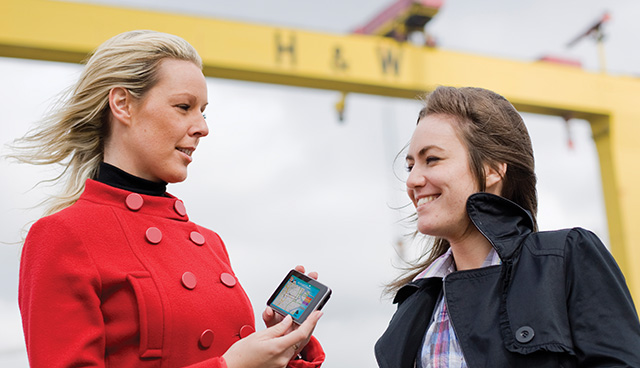Shining a digital light on Northern Ireland tourism


Dr Peter Bolan of the Ulster University Business School discusses the impact of harnessing digital media to improve the tourism experience.
When it comes to holiday and destination choice the core influencing factors such as climate, visitor attractions, good beaches, activities etc. are well known. The traditional picture has changed however. Increasingly, it’s about connectivity through digital. The tourist wants to stay connected through their smartphones and tablets. That has become the new modern essential for the holiday maker. A recent UK-based survey found that as many as one in three tourists place access to WiFi as the most desired ‘comfort’ whilst on an international trip. In the same survey a staggering 54 per cent stated they would ask a restaurant if it provided WiFi before deciding to eat there. The tourism playing field has changed.
The three strand aspects of social media, mobile applications and digital connectivity/big data are of paramount importance. Tourists are using their smartphone to check their itineraries, for researching local attractions, looking up local events, accessing maps, checking out hotel and restaurant reviews (often in-trip these days and no longer up front).
Increasingly we are seeing the use of mobile apps to also provide interpretive information at visitor attractions and event venues – and through advances in augmented reality (AR) and virtual reality (VR) offering a more immersive experience for the user. Our visitors also want to share their experiences, their images and video through social media. With the majority of social media users now accessing such platforms through their smartphone on a very regular basis, catering to such appetites and indeed obsessions has become unavoidable for businesses in the tourism arena. Such connected experiences present a great opportunity for tourism and that means they will certainly impact and dictate the need for new digital strategies going forward.
One of the areas that users of social media post and share about most is travel and their experiences whilst on vacation. As such the 21st century traveller now avidly utilises social media pre-trip to inform their decision-making and increasingly uses such platforms during their holiday to enhance their experience and share aspects of their experience with others, whilst also engaging through social media post-trip in the form of online reviews. Whilst the understanding of the need to engage with this (to join the digital conversation which is happening anyway) amongst tourism businesses and authorities and their consumers is much stronger in recent times, it is still not harnessed as effectively as it could be.
“Smartphones are now being used like a digital ‘Swiss Army Knife’, replacing possessions like watches, cameras, books, diaries, laptops and even televisions.”
Tourism growth potential
In particular, we need to examine international markets, where the tourism growth potential and interest is, and how these markets engage digitally on social media (as a one size fits all approach will have limited effectiveness). Growth potential from China as a source of visitors and tourism expenditure is vast and we have already seen signs that Northern Ireland has been benefitting from that. According to the United Nations World Tourism Organisation (UNWTO), Chinese outbound tourism expenditure grew to $261 billion in 2016 (21 per cent of the world market), an increase of plus 12 per cent from 2015 and 11 times of the amount spent a decade earlier. The actual number of outbound travellers climbed by 6 per cent to 135 million in the 2016 year (see Figure 8). This has now cemented China as the number one source of international tourism expenditure, far outweighing traditionally high markets such as the USA and Germany (currently holding the number two and three positions, respectively). Such significance as a key tourism market source is still only in its infancy. The number of Chinese passport holders is expected to double by 2020 (Skift, 2018). Currently only 5 per cent of the Chinese population actually hold a passport (Chen, 2018). Growth potential from China as a source of visitors and tourism expenditure is therefore vast.
How we reach and influence the Chinese market digitally, to encourage them to visit Northern Ireland as a destination is of profound importance. It is vital to examine who these tourists are and what drives and motivates them. Signs are the Chinese tourist is becoming more tech-savvy and digitally influenced (especially the younger generations). China’s increasingly free independent travellers are now turning to digital, social, and media pop culture for trip planning and inspiration. Just as in the west, there is a major shift to free independent travel (FIT) when it comes to researching and planning outbound travel. However, the Chinese tourist is heading digitally to WeChat (which currently surpassed one billion active monthly users), Mafengwo and Fliggy, not to Facebook, Twitter and Instagram, as happens in the West. So, the platforms and mechanisms we need to use to engage with such a market are not the same as markets nearer to home.
Smartphones are now being used like a digital ‘Swiss Army Knife’, replacing possessions like watches, cameras, books, diaries, laptops and even televisions. In tourism, businesses, operators and organisations have to recognise this thirst and indeed addiction to use mobile technology and increasingly tap into that whenever and wherever possible with specially designed and innovative mobile apps. Interpretive and experiential information (traditionally provided by signage, leaflets/brochures, guidebooks, maps and tour guides) can now be provided straight to the mobile device, but that’s only scratching the surface of what is possible. Bespoke apps utilising wider multi-media elements (video and audio), augmented reality (AR), virtual reality (VR), personalised/tailored tour functionality, gaming aspects (gamification) and location-based elements (enabled by GPS etc) can enhance the tourist experience to whole new levels.
As all this develops however, we increasingly need ‘smart’ facilities: smart hotels, smart restaurants, smart visitor attractions, smart event venues etc. In fact, we need to start moving much more seriously towards this on a larger scale with smart resorts and smart cities. Connectivity of high and reliable quality is required for all this to work effectively to everyone’s benefit. Lack of WiFi or poor quality WiFi, and poor mobile network coverage will make what today’s digitally focused tourist consumer wants impossible. If we get that right and combine it with the correct approach on social media and smartphone applications then we can also harness the vast array of data that such aspects will generate and provide. Giving us a strong vantage onto visitor behaviour that will, in many respects, be unparalleled in terms of customer touch-points and on-site evidence of traveler sentiment.
Security
Hand-in hand with such developments will require a greater level of cyber security as well. A recent study by mobile threat defence company Skycure tracked attacks on mobile devices at popular travel destinations around the world. They found that 15 of the world’s most popular tourist sites posed especially high risks to tourist mobile users (key threats being theft of private information such as passwords and bank details as well as access to social media accounts). New York City’s Times Square was found to be the most vulnerable site, followed by the likes of Notre Dame Cathedral in Paris, Disneyland Paris, Golden Gate Park in San Francisco, Ocean Park in Hong Kong and the Las Vegas Strip. So, we must tread carefully as well. However, if we fully embrace what digital can achieve, tap into what such consumers want and need (especially those in growing markets like China), continue to innovate with the right approach and vision, then our already bright tourism future in Northern Ireland looks potentially even brighter still.







